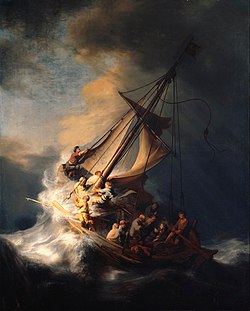Synoptic Gospels

The Synoptics or Synoptic Gospels (from Greek: συνόψις syn-opsis "looking together") are called the three evangelists Mark, Matthew and Luke respectively their gospels, the Gospel of Mark, the Gospel of Matthew and the Gospel of Luke in the New Testament. They describe and interpret the life and teachings of Jesus from a comparable perspective. That is why Johann Jakob Griesbach first had the texts printed in columns next to each other in 1776 for better comparison, producing a so-called synopsis. This is why the first three Gospels are called synoptic.
Although the Gospel of John roughly coincides with the content and structure of the three synoptics, the three synoptic Gospels have far more in common with regard to language and the common textual material.
According to Rudolf Steiner, both the Synoptics and John the Evangelist were initiates, each coming from different schools of initiation. Only John was also a direct eyewitness. The other Gospel writers, the Synoptics, took the material from the Akasha Chronicle.[1]
„Thus the Gospels are a renewal of the old descriptions of initiation, of the old initiation rules, and the writers of the Gospels said to themselves: Because that which otherwise only took place in the depths of the Mysteries once took place on the great plan of world history, therefore it may be described in the same words as the initiation rules are written. But that is why the Gospels are never meant as external biographies of the Christ-bearer. That is precisely the misunderstanding of modern Gospel research, that one wants to look for such an external biography of Jesus of Nazareth in it.“ (Lit.:GA 131, p. 31)
„When I approach the Gospels myself, no matter how often, I always have a very specific feeling, namely that in the Gospels, no matter how far one has understood them, what one has thought and said from them and about them - and I emphasise this explicitly, no matter how often one approaches them - one always encounters something new. You never stop learning about the Gospels. But this learning from the Gospels is connected with something else; it is connected with the fact that the more one occupies oneself with them, the more admiration one feels for the depth of the content, precisely for, I would like to say, the immensity into which one is immersed and which actually evokes the feeling that there is no end to this possibility of immersion, that this admiration grows with every time one delves into the Gospels. However, one has some difficulties with regard to this path, which consist in the fact that when one has taken a few steps into the Gospels - I say "into" explicitly - one stumbles over the (textual) tradition. This is less of an obstacle for the actual spiritual scientist, because he is confronted with something like the Gospels with their, one might almost say, wordless text, and that makes it easier not to stumble over the tradition. Admiration, however, seems to me to be an indispensable element if the reading of the Gospels is to provide the basis for a religious teaching work for the individual person.“ (Lit.:GA 343, p. 190f)
Literature
- Rudolf Steiner: Von Jesus zu Christus, GA 131 (1988), ISBN 3-7274-1310-7 English: rsarchive.org German: pdf pdf(2) html mobi epub archive.org
- Rudolf Steiner: Vorträge und Kurse über christlich-religiöses Wirken, II, GA 343a (1993), ISBN 3-7274-3430-9 English: rsarchive.org German: pdf pdf(2) html mobi epub archive.org
 |
References to the work of Rudolf Steiner follow Rudolf Steiner's Collected Works (CW or GA), Rudolf Steiner Verlag, Dornach/Switzerland, unless otherwise stated.
Email: verlag@steinerverlag.com URL: www.steinerverlag.com. Index to the Complete Works of Rudolf Steiner - Aelzina Books A complete list by Volume Number and a full list of known English translations you may also find at Rudolf Steiner's Collected Works Rudolf Steiner Archive - The largest online collection of Rudolf Steiner's books, lectures and articles in English. Rudolf Steiner Audio - Recorded and Read by Dale Brunsvold steinerbooks.org - Anthroposophic Press Inc. (USA) Rudolf Steiner Handbook - Christian Karl's proven standard work for orientation in Rudolf Steiner's Collected Works for free download as PDF. |
References
- ↑ Cf. Friedrich Göbel: Die Evangelisten. Eine biographische Betrachtung, Vlg. Edition Die Pforte, Dornach 1995
